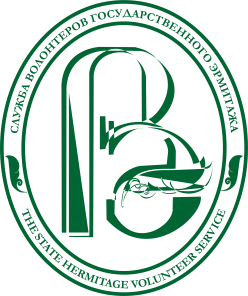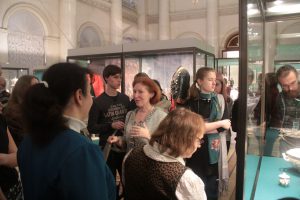On the 17th of March, 2017, Hermitage volunteers were given a tour of the exhibition «From the Serving Pantries. The Decoration of the Russian Imperial Table». This wonderful tour was conducted by the head of the Hermitage school centre Irina Dyubanova.
The exhibition featured more than 1200 exhibits from the collections of the Hermitage, the Russian Museum as well as the palaces of Pavlovsk and Peterhof and the Moscow Kremlin Museum. It featured examples of the decoration of the tables at receptions in the Imperial residences and Grand-Ducal palaces: porcelain dinnerware, ceramic tableware, glass, gold and silver, and a small sculpture commissioned specifically for the celebration decorated the table.
Irina began her story with a description of the clothing of the keepers of the Tzar’s tableware, and also pointed at the special baskets and boxes, in which porcelain was stored and transported in those days. All the sets are carefully stored in specially equipped premises – Service pantries.
Next, the volunteers were presented a wedding service, presented to Nicholas II and Alexandra Feodorovna in 1894 by German Emperor Wilhelm II. The service, created by the Berlin Royal porcelain manufactory, is striking in its elegance and beauty. The white porcelain is decorated with very delicate pink and purple flowers– a symbol of love, spring and innocence. The wedding table was decorated with artfully folded napkins which a guest could unfold in a single motion.
Irina gave special attention to the famous Russian Order of the Gardner porceline production manufacture (St. George, St. Andrew, Alexander, Vladimir), it was used for festivities in honour of the knights of the four highest Russian awards. At receptions Catherine II poured the soup with the laddle, taking care of guests. Whilst leaving the dinner, the guest could walk away with a gift: a plate from this dinner service. Each set is decorated with the insignia, star and ribbon of the relevant state awards.
Volunteers remembered the story of the famous Blue Dinner Service or the Cameo Dinner Service, created by the Sèvres porcelain manufactory between 1778 and 1779, having been commissioned by Empress Catherine II. Following a fire in the Winter Palace in 1837 all the jewels were placed on the Palace square and the Royal family didn’t notice anything amiss. However, part of this set deposited in the Admiralty, had disappeared and a few years later were auctioned abroad. The Royal family tried to buy back the missing part of the service. Later, the Russian masters of the Imperial porcelain factory tried to recreate this service, but it was impossible to replicate the unusual sky blue/turquoise, as the original was made in Sèvres out of soft porcelain, and then a copy – out of solid porcelain. Only in the production of soft porcelain, in which the temperature in the furnace is lower, can you use paint which give such an amazing rich shades. Even in France, the recipe for the production of soft porcelain at that time had been lost.
A very interesting and original Hunting service (Meissen, 1766-1768.), and St. Andrew service decorated with a lemon, asparagus, artichoke and mushrooms (Meissen, 1744-1745). Volunteers remembered the vases for sweets and fruits, adorned with flowers, made in openwork trellis. Striking beauty gold plated bronze vases and candlesticks. In those days the tables were decorated with fresh flowers and even trees in pots to give guests the impression that they are at a table outside, rather than indoors.
Until the mid-18th century tableware to the Russian court came primarily from foreign manufacturers. But later, on the eve of the Christmas celebrations at the Winter Palace had far better products created by the Imperial porcelain manufacturers in St. Petersburg.
Silver and gold dishes held an important place in a serving Royal table. Irina said that in the 18th century in Russia there was a consistent supply of food to the table. Thus the guests could sample each hot meal. The tables were assembled into complex compositions, for example in the form of the Imperial crown, sea shells or spirals. A similar design was conceived, taking into account the public nature of the ceremonial meals, when viewers were allowed onto the balcony.
We were struck by the dazzling richness, magnificence and diversity of the exhibition. The atmosphere of the celebration left no one indifferent. The Hermitage volunteers really enjoyed this tour, which was masterfully conducted by the Director of the Hermitage School centre Irina Dyubanova.
Written by Elena Verkhovskaya, volunteer, Russia.
Translation by James Lofthouse, volunteer.







